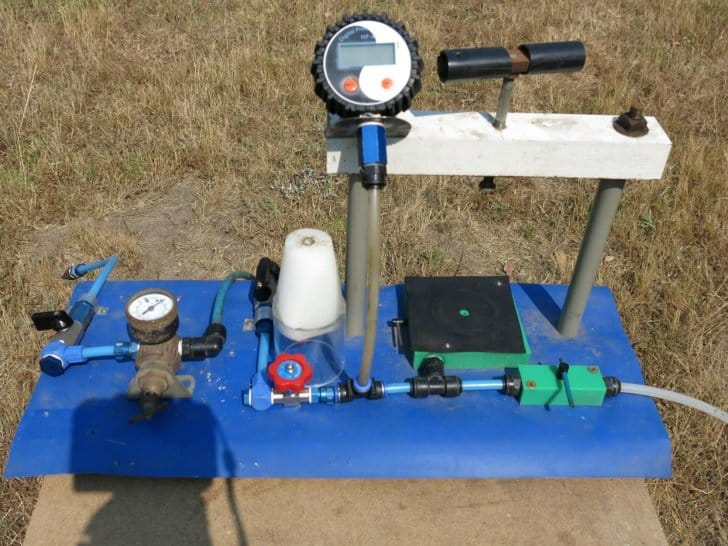Introduction
In this article, I present a DIY hydrostatic pressure testing device (and test results for 30 fabrics) that allows me to measure the hydrostatic head of “waterproof’ fabrics at home.
The device is made from readily-available and inexpensive parts. I also present my protocol for running the device and a discussion of some of the fabrics I tested.
Context
A major problem when buying fabric is that it can sometimes be hard to get a sample to examine in your hand to see whether it might be suitable for your project. It can be even harder to find out whether it will be sufficiently waterproof to serve as the fly for your next tent. There is the usual marketing spin, but I don’t place any faith in those guys.
My solution is to test a sample of the fabric myself to see, among other things, just how waterproof it is. This is usually done commercially with a thing called a Suter Tester, but even the simplest manual ones are expensive to buy.

The concept here is to clamp an area of the fabric to a solid base plate and then to inject water under pressure through a small hole in the middle of the base into the space between the two, to see at what pressure the fabric starts to leak. The standard threshold for a leak is at least three drops of water visible coming through the fabric – usually slowly at first. The pressure at which this occurs is usually known as the hydrostatic head (HH).
Making Your Own Hydrostatic Head Measurement Device
So, I have made my own version of the Suter Tester (several of them in fact).
The first one relied on a hose going up in the air to measure the water pressure, but that one was limited by how high up in the air I could take the tube (a maximum of 3000 mm). Climbing a high ladder to make a measurement was not wise as the height of the water column could change while I was getting up the ladder.
The second version used a commercial round analogue pressure gauge instead of the tube going up in the air, but the resolution on the ones I had was very coarse. Mind you, if you can find a large pressure gauge with the right range, it might be good enough. The waterproofness of any fabric is not usually uniform across the surface area of the fabric, so high resolution may be pointless.
My third version used an industrial strain-gauge pressure sensor. While sensitive and able to provide more resolution than what I needed or could justify, it required lots of electronics and power. That was possible, but it was bulky.
The fourth version uses a commercial battery-powered digital air-pressure sensor with a built-in digital readout. I found it on eBay and it was quite cheap. Just how accurate it is I do not know (a few percent?), but it is good enough for this task. The rest of the device uses cheap pneumatic fittings, pneumatic hose and a slab of solid plastic, all mounted on a board covered with some heavy blue waterproof material (I don’t want the base board always wet).

The fabric to be tested is placed on the black rubber square (1), on top of a slab of green plastic (2). It has a hole in the middle (3). The bit of clear plastic tube (4) with the white lump on top (behind the red knob) is the clamp that fits over that fabric and presses down on the solid base underneath to make the test region. If you look carefully you can see the ring-mark on the rubber. This is the core of the instrument.
Member Exclusive
A Premium or Unlimited Membership* is required to view the rest of this article.
* A Basic Membership is required to view Member Q&A events




Home › Forums › Measuring Waterproofness in Outdoor Performance Fabrics with a DIY Hydrostatic Pressure Test Device at Home